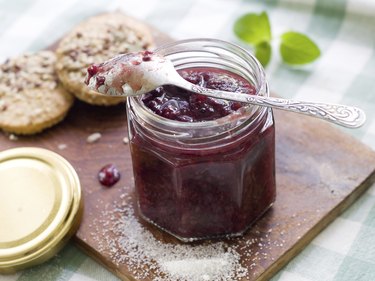
Sugar does more than sweeten fruit. Sugar helps fruit retain its color and texture, and works with pectin, a natural thickener found in fruit, to set jam or jelly. You can use stevia when you can fruit by modifying the cooking technique or using modified pectin.
Jams and Jellies With Stevia
Video of the Day
Sugar and pectin have a good working relationship. Sugar is hydrophilic, so it pulls water out of pectin when it reaches the thread stage at around 220 degrees Fahrenheit. When pectin loses moisture, it bonds with other pectin molecules and gels, which gives jam structure and stability. Jams and jellies made with regular pectin won't set properly without sugar, so modified pectin, which sets in the presence of calcium, must assume the role if you use stevia. Use 1 teaspoon of powdered or liquid stevia for every 1 cup of fruit when you make jam or jelly, and use a pectin labeled "low-sugar" or "no-sugar."
Video of the Day
Canning Fruit With Stevia
Substituting stevia for sugar or sugar syrup when you can fruit doesn't affect preservation. In this technique, sugar helps the fruit maintain its texture and shape, not extend its shelf life, because the hot-pack canning process does the preserving and ascorbic acid or lemon juice retains the color. Fruit quality is important when canning without sugar, so only use fruit at the height of ripeness, or fruit you purchased within two days of harvest. Mix 1 gallon of water with 3/4 cup of lemon juice, 3,000 milligrams of crushed vitamin C tablets or 1 teaspoon of citric acid and dip the peeled and sliced fruit in the mixture before packing it in the jars. Mix filtered or spring water with stevia to taste and pour it over the fruit, leaving 1/2 inch of head space.
Grinding Fruit Pulps With Stevia
Fruit pulps have little sugar and moisture and, when combined with a little reserved juice and stevia, make a dense paste with a consistency closer to regular jam than low-sugar jam with modified pectin. After peeling and seeding the fruit, grind it using the grinder attachment of a stand mixer. Use a coarse or medium blade. You can also mash the fruit using a fork. Don't use a juicer or food processor because the juicer's masticater and processor's blades are too powerful and render the pulp too smooth.
Canning Fruit Pulps With Stevia
After you grind the fruit, heat it on the stove for about five minutes over a low heat, then drain it for 15 to 20 minutes in a mesh strainer lined with four layers of cheesecloth. Heat the pulp again and sweeten it to taste with stevia. Add 2 tablespoons of lemon juice for ever 4 cups of pulp and pack it into jars, leaving 1/2 inch of head space.
Relishes and Pickles With Stevia
You won't get good results from canning pickles and relishes with stevia. Pickles and relishes rely on real sugar for their texture, color and classic pickle taste. Pickles made with stevia turn out mushy, have a grayish cast and taste cloyingly, artificially sweet.